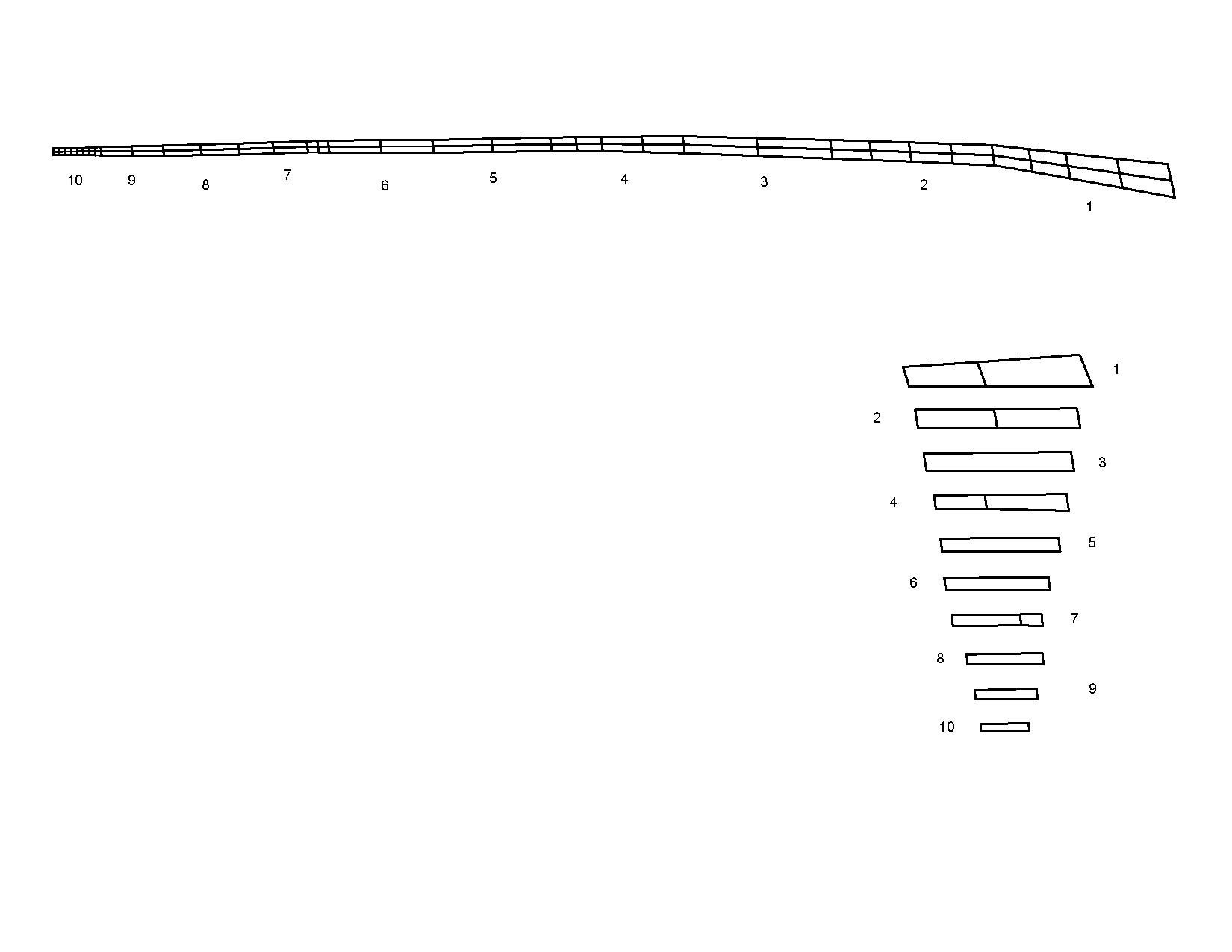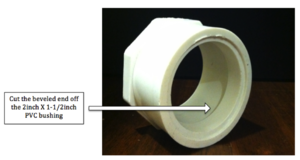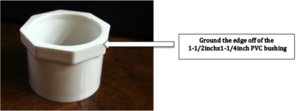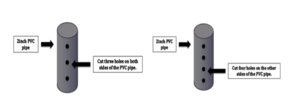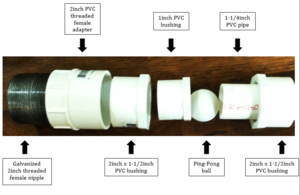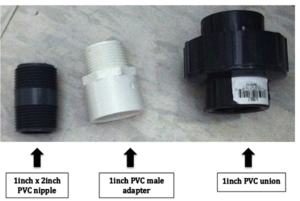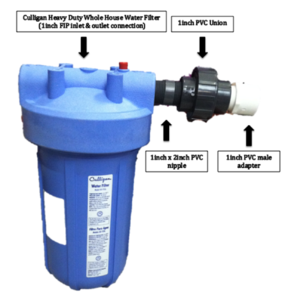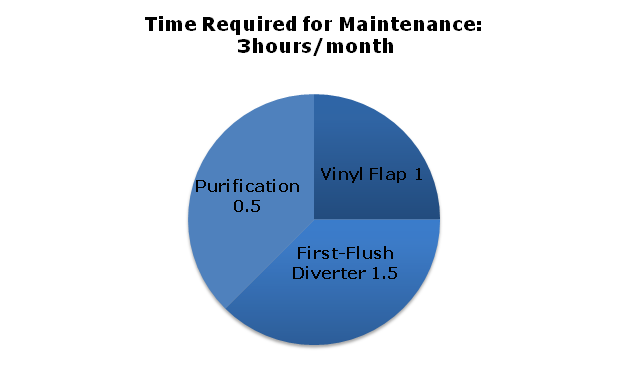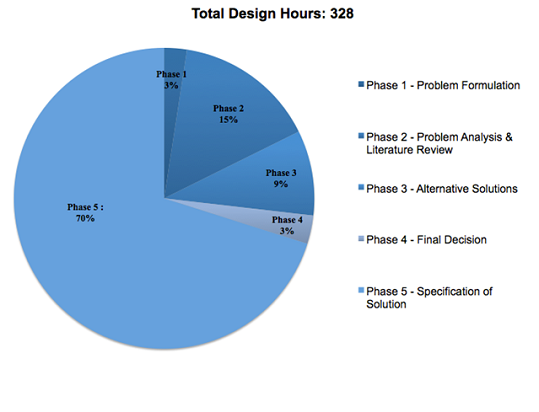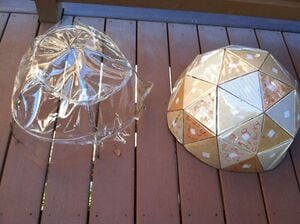
The Replenish Life Team, Malia Sierra Breeze Gonzales and Neftali Eunice Romero, have created a rainwater catchment system that is intended to provide potable water for two to ten people that will be living on a barge. The barge is where the WetLand Project will be implemented on, and is a collaborative project between Live Arts/Fringe, Mary Mattingly, and Humboldt State Fall 2013 Engineering 215 Students. The components needed to build a rainwater catchment system for safe potable use are: a catchment system, a filtration system, a purification system, and a storage system. The Replenish Life Team intends to describe, on this webpage, the steps required to build and maintain a rainwater catchment system for the WetLand Project.
Background[edit | edit source]
-
The WetLand Project
The WetLand Project is collaboration between Live Arts/Fringe, Mary Mattingly, and Cal Poly Humboldt Engineering 215 students. The WetLand Project is a temporary public art installation for the summer of 2014, located on the Delaware River in Philadelphia. The project is an island based ecosystem and a floating mobile habitat; that intends to educate the Philadelphia community about sustainable use and living, by being a representative and partner in the world of socially involved visual arts. The floating mobile habitat is barge with three domes that supports two to ten people.
Problem statement[edit | edit source]
A standard rainwater catchment system is usually built off of a square roof with the use of attached rain gutters. For the WetLand Project, the Replenish Life Team is required to design a rainwater catchment system off of a geodesic dome by using billboard vinyl as the main material.
Criteria[edit | edit source]
The criteria and constraints are established by the collaboration between the clients of the WetLand Project and the Replenish Life Team. The table below defines the criteria needed to be met by the final design ranked by importance with weighted values(0-10) .
| Criteria | Constraint | Weighted Value |
|---|---|---|
| Water Safety | The water needs to meet the EPA regulations for safe potable use. | 10 |
| Cost | The total cost for materials and maintenance required for potable use, cannot exceed the budget of $265. ($100 from the client and $165 from the team) | 10 |
| Level of Autonomy | The minimum volume of water required between a rain event. | 9 |
| Maintainability | The minimum time required to clean the rainwater catchment system is four hours per month. | 7 |
| Durability | The minimum time the rainwater catchment needs to be permanent is three months. | 6 |
| Aesthetics | A unique and creative sci-fi theme designed for the public. | 3 |
| Environmental Justice | A consideration of recycled materials for the design. | 2 |
Description of Final Design[edit | edit source]
Based upon the criteria presented, the Replenish Life Team designed a rainwater system called Jawbreaker. Jawbreaker uses an intricate spiral design functioning as the catchment system, a first flush diverter for filtration, two different size micron filters, and six 55-gallon drum.
The catchment system will be implemented on 16ft and 10ft diameter domes. A vinyl flap will be stitched into a spiral design starting from the top of the dome, traveling one and a half full revolutions around the geodesic dome. To prevent the vinyl flap from falling over and closing in on itself from the weight of the water the team used discarded pens, grommets, and string. The pens are used for structural support of the vinyl flap. The string is used to secure the grommets in order to prevent the vinyl flap from collapsing.
Water will flow down the vinyl flap into a 5-gallon bucket. A first-flush diverter will capture the first ten minutes of collected rainwater off the dome to discard any debris entering the storage tanks. The first flush diverter contains a plug and ball at the bottom of the PVC pipe. Once the ball floats to the brim of the pipe, closing the chamber, clean water will flow into a surge tank.
The overflow mechanism uses a surge tank and a discharge mechanism to prevent water from back flowing into the 5-gallon bucket. The back pressure from the filters during a big rain event causes back flow.
The purification system filters water before it becomes stagnant, preventing bacteria growth. We specifically chose to use two ceramic filters so we would be able to lower the maintenance cost for the residence on the barge. The ceramic filters used are a 25-micron and 5-micron.
-
AutoCAD drawing for the Final Design
Implementations and Specifications[edit | edit source]
The Implementation and Specification Section will cover the steps required to implement the final design of the Replenish Life Team.
| Product | Total | Section |
|---|---|---|
| Vinyl Billboard Material | 10 flaps | Catchment |
| 1/4inch grommet | 30 | Catchment |
| Discarded Pens | 20 | Catchment |
| Nylon Rope | 1 | Catchment |
| Nylon Thread | 1 | Catchment |
| 5-gallon bucket | 2 | Filtration |
| Lid for a 5-gallon bucket | 1 | Filtration |
| Galvanized 2inch threaded female nipple | 1 | Filtration |
| 2inch PVC threaded female adapter | 1 | Filtration |
| 2inchx1-1/2inch PVC bushing | 1 | Filtration |
| 1inch PVC bushing | 1 | Filtration |
| 2inch PVC pipe | 2 (9inch and 39inch) | Overflow |
| 2inch PVC adapter | 1 | Overflow |
| 90 degree elbow | 6 | Overflow |
| 1inch PVC union | 4 | Purification |
| 1inchx2inch PVC nipple | 4 | Purification |
| 1inch threaded male PVC adapter | 4 | Purification |
| 1inch PVC pipe | 6 | Purification |
| Culligan Heavy Duty Whole House Water Filters | 2 (25 and 5 micron) | Purification |
| 55-gallon drums | 6 | Storage |
| Product | Total | Section |
|---|---|---|
| 110/18 Needle size | 1 | Catchment |
| UGlu | <15feet | Catchment |
| 2-1/4inch PVC hole saw | 1 | Filtration |
| Chirsty's Red Hot Blue Glue (Solvent) | As much needed | Filtration, Overflow, Purification, & Storage |
| Oaten Purple Primer | As much needed | Filtration, Overflow, Purification, & Storage |
| Teflon tape | As much needed | Filtration, Overflow, Purification, & Storage |
| Plumber's grease | As much needed | Filtration, Overflow, Purification, & Storage |
| 7/8inch Spade bit | 1 | Overflow |
| Sharpie | 1 | Catchment, Filtration, Overflow, Purification, and Storage |
| Jigsaw | 1 | Overflow |
| Hachsaw | 1 | Overflow |
| Hole saw | 1 | Purification |
| 3/4inch drill bit | 1 | Storage |
Catchment[edit | edit source]
| Vinyl Flap | |||||||||||||||||
|---|---|---|---|---|---|---|---|---|---|---|---|---|---|---|---|---|---|
| Steps | Instructions | ||||||||||||||||
| Step 1 Acquire Materials |
| ||||||||||||||||
| Step 2 Measuring the Vinyl Flap
File:Dome Cover 2v (2) byGabrielKrause.pdf 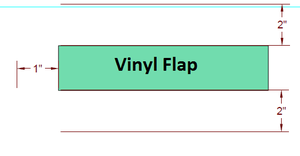 |
1. For all flaps use a sharpie to trace the shapes, as shown in the pdf file by Gabriel Krause.
2. Extend the edges by drawing dashed lines, as shown on the image. 3. The extensions need to be 2inches on both the top and bottom of the flap; and 1inch on both short sides, image 2. Apply the extensions for all flaps. 4. Make sure to mark the flaps accordingly; the numbers will be used for the attachment process. | ||||||||||||||||
| Attaching Grommets to Vinyl Flap | |||||||||||||||||
| Steps | Instructions | ||||||||||||||||
Step 3 Seamed Edge
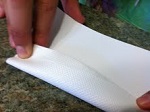 |
1. Start with flap number 1.
2. Fold the top of the flap 1inch. Turn under the raw edge and edge-stitch the fold. 3. Fold flap number 2, and create the seamed edge-stitch like flap number 1. Follow the instructions for all flaps except for flap number 10. | ||||||||||||||||
Step 4 Determine Grommet Position
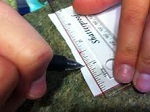 |
1. Start with flap 1.
2. Use the male side of the grommet to mark the position and work with the downside of the vinyl facing up. 3.On the fold of flap mark the center of each grommet a quarter inch from the edge. | ||||||||||||||||
Step 5 Position Grommet
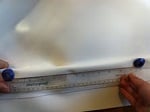 |
1. Draw the center circle of each grommet and place each grommet one foot apart. | ||||||||||||||||
Step 6 Insert Grommet
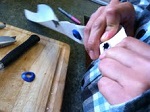 |
1. At the center of each drawn circle, cut an X and insert the male portion of the grommet.
2. Place the female portion of the grommet over the portion sticking out. 3. Use the Grommet tools to connect the grommets pieces. 4. Make sure to insert the grommets through the front of the flap and secure them through the back. | ||||||||||||||||
| Supports for Vinyl Flap | |||||||||||||||||
| Steps | Instructions | ||||||||||||||||
Step 7 Rectangle Support
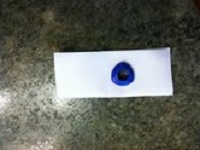 |
1. Grab uncut vinyl billboard material 2. Cut 2inch in height and 2inch in length to form a rectangle. Make 15 rectangles. 3. Grab a rectangle, measure the 1inch side with a ruler and mark with a sharpie a 1inch fold line. 4. Fold the rectangle and create seamed edge like vinyl flap. 5. Insert grommets in the center of the rectangle. Proceed on all 15 rectangles. | ||||||||||||||||
Step 8 Pen Supports
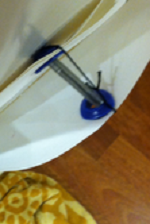 |
1. Grab discarded pens. (20) 2. Take ink out of the pen to form a tube. 3. Grab the tube and measure with a ruler 3inches long. 4. Cut tube at 3inches with a box cutter. | ||||||||||||||||
| Attaching Supports and Vinyl Flap to dome | |||||||||||||||||
| Steps | Instructions | ||||||||||||||||
Step 8 Arrange Flaps
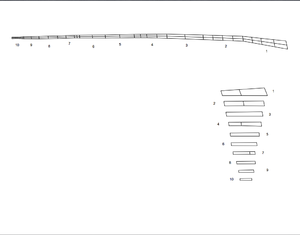 |
1. Grab the vinyl flaps and arrange in order, starting with 1. 2. Make sure to arrange them so that the sides correspond to each other. 3. Use a industrial sewing machine and appropriate needle to sew the corresponding sides together to create one long flap. 4. For the single stitch pattern use 5 stitches per inch. The term single stitch will mean this pattern through out the entire tutorial. | ||||||||||||||||
Step 9 Sewing
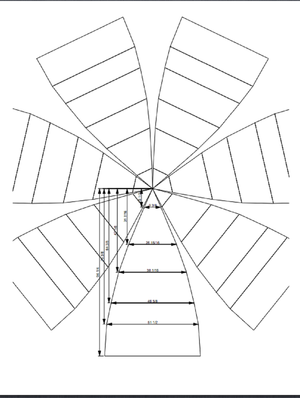 |
1. Using an industrial sewing machine and start with flap 1 (longest flap).
2. Single stitch the base of the flap at an angle that allows for one and a half full revolutions. | ||||||||||||||||
Step 10 Attaching Supports
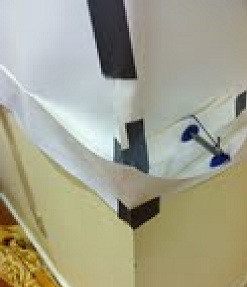 |
1. Place each rectangle with attached grommets onto the dome material. 2. Match each rectangle with grommets parallel to the grommets that are attached to the vinyl flap. 3. Single stitch the base of the rectangle (2inch in length) and both sides of the rectangle (1inch in width). 4. Proceed to all rectangle attachments. 5. Make sure to leave the top unstitched. 6. Grab the tubes with string sticking out both ends. 7. Place each tube in between each vinyl flap grommet and the rectangle vinyl grommet. 8. Loop each side of the nylon rope through each grommet. 9. Once through each grommet pull rope together to tie a knot. 10. Make sure the tubes are tight and straight between the vinyl flap and rectangle. | ||||||||||||||||
| The Final Touch | |||||||||||||||||
| Steps | Instructions | ||||||||||||||||
| Step 11 Final Touches | 1. Grab the UGLU non-toxic tape.
2. Put the UGLU tape on the seam that is inside the Vinyl Flap. 3. The tape needs to be applied along the entire sewn portion of the flap. | ||||||||||||||||
Overflow Mechanism[edit | edit source]
| Cutting the Pieces | |
|---|---|
| Steps | Instructions |
| Step 1 Acquire Materials | Materials:
|
Step 2 Cut the Surge Tank
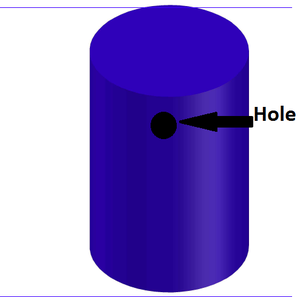 |
1. Use the sharpie and the threaded side of the PVC adapter to draw an outline on the brim of the surge tank. Make sure to cut the side of the surge tank that is closest to the edge of the barge.
2. Use the Power drill with 7/8inch spade bit to cut an insertion hole. 3. Grab the jigsaw and cut the drawn circle. 4. Add a thread to the hole by using the adapter and inserting it. Do not leave the adapter in the hole. |
| Step 3 The Elbows | 1. Use the primer and solvent to connect the PVC pipe to the elbows.
2. Start with the 9inch piece of PVC pipe and the 90 degree elbow's. 3. Start by applying the primer to the socket of the elbow and the tip of the PVC pipe. 4. Apply the solvent about 80% to 90% in the socket. Also apply solvent to the tip of the PVC pipe. 5. Connect the elbow and the PVC pipe that has the primer and glue by applying a perpendicular force. Make sure to apply a small twist while connecting the elbow and the PVC pipe. 6. Do the same steps for the 39inch PVC pipe and all other connection pieces. |
| Step 4 Putting it All Together | 1. Use the Plumber's grease to coat the threaded PVC adapter.
2. Add primer and solvent to both the PVC pipe and the socket of the PVC adapter. Follow the guidelines in Step 3. If necessary, please watch this YouTube video to see proper joint attachment process. |
Filtration[edit | edit source]
Purification[edit | edit source]
Storage[edit | edit source]
| Storage Tanks | |
|---|---|
| Steps | Instructions |
| Step 1 The Tanks | 1. Arrange six 55-gallon drums in a circle.
2. Draw with a sharpie a 3/4inch insertion hole on the base of each 55-gallon drums. Keep in mind you will need to draw two holes for each 55-gallon drum in order to be able to connect all six drums. 3. Use the 3/4inch drill bit to cut two holes at each base of all six 55-gallon drums. 4. Place a 1inch PVC male adapter in the 3/4inch drill bit cut hole for all six 55-gallon drums . 5. Cut a 1inch PVC pipe. The length of the PVC pipe depends on how far the 55-gallon drums are from each other. Measure the length after the drums are properly positioned in a circle on the barge. |
Step 2 Put it all together
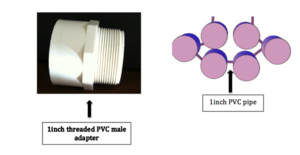 |
1. Apply Teflon tape to all the threaded 1 inch PVC male adapters.
2. Apply Plumber's grease to the threaded 1 inch PVC male adapter and inside the drill bit hole. 2. Use the primer and solvent to connect 1 inch PVC pipe to the socket of the 1 inch PVC male adapter. 3. Start by applying the primer to the socket of the 1 inch PVC male adapter and to the 1 inch PVC pipe. 4.Apply the solvent about 80% to 90% in the socket of the 1 inch PVC male adapter. Also apply the solvent to the tip of the 1 inch PVC pipe. 5. Connect the socket of the 1 inch PVC male adapter and the 1 inch PVC pipe that has the primer and solvent applied on. 6. Use a perpendicular force when connecting the 1 inch PVC pipe and the 1 inch PVC male adapter. (Make sure to apply a small twist while connecting the 1 inch PVC pipe and 1 inch PVC male adapter) 7. Do the same steps to connect the rest of the 1 inch PVC pipe and 1 inch PVC male adapter. Follow the guidelines in Step 2. If necessary, please watch this YouTube video to see proper joint attachment process. |
Maintenance[edit | edit source]
The maintenance required by Jawbreaker is three hours per month. The time required to clean the catchment system is broken into sections as shown in the Pi-chart.
To clean the vinyl flap the residence will need to spend a combined time of one hour per month. Cleaning the vinyl flap will include making sure no debris is gathering along the stitch and removing any debris that is caught on the catchment.
To clean the purification system the residence need to spend a total of thirty minutes per month. Cleaning the Purification will require the residence to check on the connections on the purifiers.
To clean the first flush divert the residence will be required to spend a total of one hour and thirty minutes. Cleaning the first flush diverter will require the residence to rinse the 5-gallon bucket attached to the first flush and add Plummer's Grease every time the first flush diverter get remove.
Costs[edit | edit source]
The implementation cost is the money we spent on making a prototype and for the materials to replicate the design on the actual dome. The total cost is $155.91. The Replenish Life team saved the client $421.49, due to donations of materials and discounts at ace.
| Materials | Quantity | Total Team Cost ($) | Total Retail Cost ($) |
|---|---|---|---|
| Vinyl Sheet | 1 | 29.89 | 29.89 |
| Vinyl Tube | 1 | 1.40 | 1.40 |
| Saucer Plant | 1 | 0.17 | 0.17 |
| Duct Tape | 1 | 6.99 | 6.99 |
| Black Dura Pot 3 1/2" | 1 | 0.17 | 0.17 |
| Wire Steal | 1 | 2.43 | 2.43 |
| Origin Design | 2 | 60.00 | 60.00 |
| UGlu | 1 | 6.89 | 6.89 |
| ResQ-tape | 1 | 4.99 | 4.99 |
| Storage Tanks (55 gal) | 10 | Donated | 399.50 |
| Billboard Vinyl | 1 | Donated | 40.00 |
| Total Cost ($) | 112.91 | 552.41 |
The Total Design hours are the hours spent on the project, which are broken down into phases.
Discussion[edit | edit source]
References[edit | edit source]


